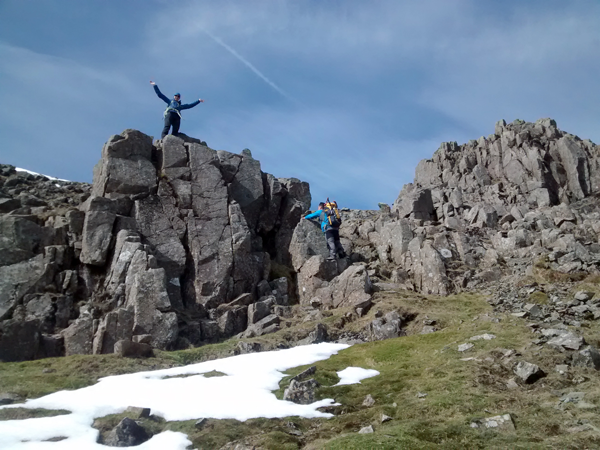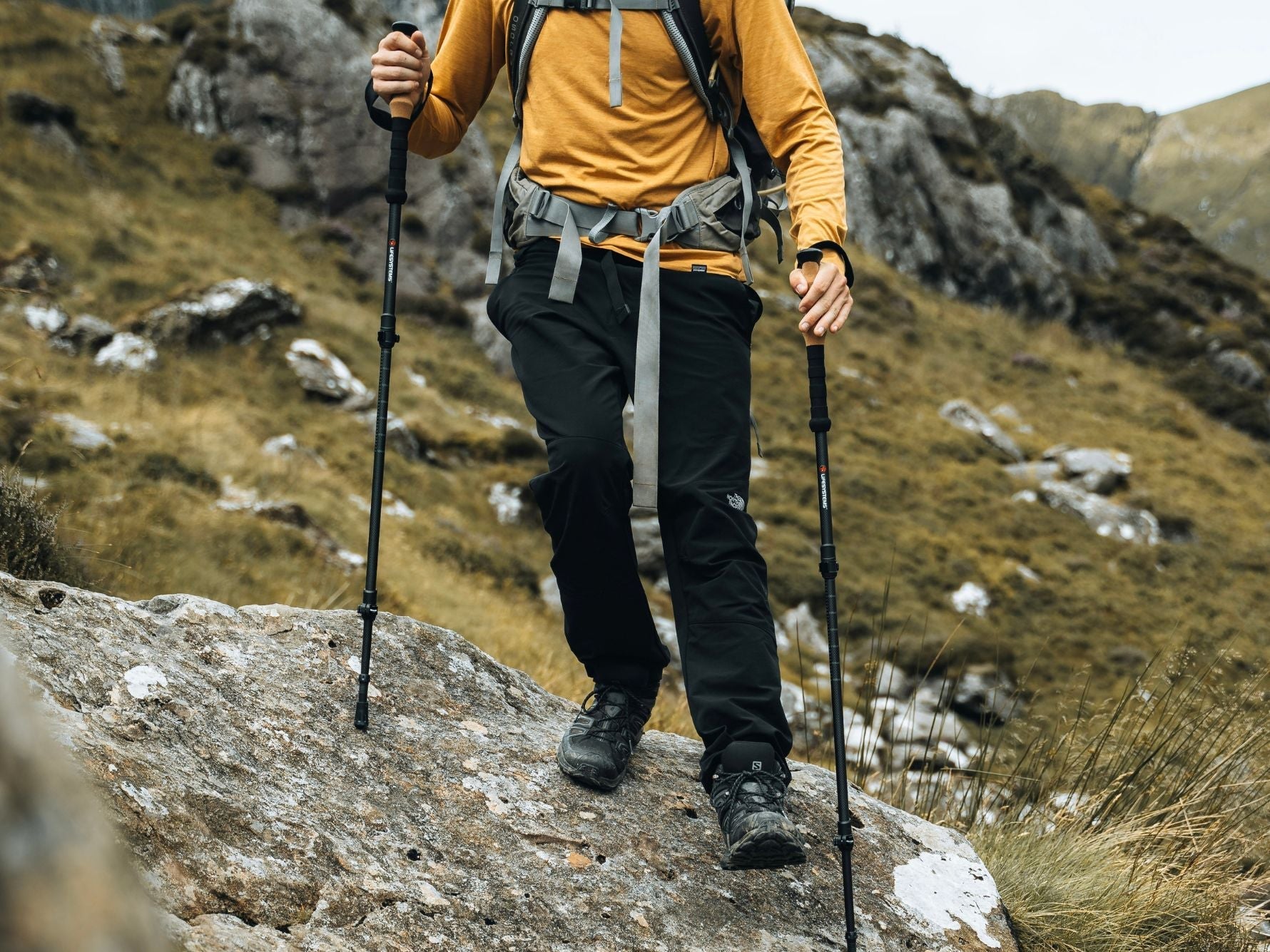Get into scrambling by Dan Aspel
- Adventurers
- Blog

Early spring scrambling in the western Lake District. The perfect time to get your hands on rock.
There’s no need to overthink scrambling. It’s just like walking, except you throw your hands into the mix. And tackle ground that’s a little steeper (and at times a lot steeper). It’s a thrilling blend of outdoor practices and is, in the words of one outdoor writer, “too exciting to be just hillwalking, but not difficult enough to be genuine rock-climbing”. Consequently it’s accessible, almost universally appealing and possible to enjoy wherever there is rock or contour. Here are a few more thoughts on the topic:
“I am reluctant to define scrambling. It’s something enjoyed in so many different ways, by so many different people… the good company… the conversation, the chit-chat, the out-there, the freedom, the fluidity, the exploring, being unencumbered…”
Garry Smith, North Wales Scrambles (Northern Edge Books)
“Unroped scrambling is potentially one of the most hazardous of mountaineering activities. A simple slip or a single hold breaking off may have fatal consequences… if there are inexperienced or nervous member in the party then a rope should certainly be carried, and it should come out of the rucksack sooner rather than later”.
Noel Williams, Skye Scrambles (Scottish Mountaineering Club)
“Scrambling is the moment you take your hands out of your pockets”
Anon
Some interesting points there. Scrambling can clearly be fluid, fun and simple. It can also be hazardous and technically difficult. The question is: how can one pastime vary so wildly?
Tryfan seen from Pen yr Ole Wen - a view only accessible by scrambling.
At the core of this question is the very nature of scrambling: it is an expression of freedom. While sticking to paved tracks and wilderness paths can make for an enjoyable day out no matter what your experience levels (even the most proficient mountaineer likes to let their mind exhale on easy terrain every now and then), scrambling tends to seek out strange lines and unfamiliar ground. The joy of climbing over rough rock and soil comes when there is no guiding line, where the random and chaotic nature of the ground represents the challenge that must be overcome and where your body must adapt itself to traverse something not built for the comfort of the human form. Consequently there are times when scramblers will be presented with dangerous situations and severe drops. How significant that danger will depend upon that individual’s appetite for thrill vs their tolerance levels for terror. The choice is theirs.
 Nearing the summit of Cnicht. A walker sees the path to the right, a scrambler sees possibilities.
Nearing the summit of Cnicht. A walker sees the path to the right, a scrambler sees possibilities.
High above Wasdale having “threaded” Napes Needle, a route thrilling and challenging in equal measure.
So that’s a little about the philosophy of scrambling. On a practical level it is a very straightforward hobby to try for yourself, particularly in the British Isles. That’s because the fact that our highest peak doesn’t make it any higher than 1344m (or roughly a third the height of the European Alps and a mere 15 per cent the height of the world’s tallest mountains) is actually an advantage. If you were to slice off the top tenth of the Himalayan 8000ers you’d find they look much like the sharp and exciting parts of Blencathra or Helvellyn or Snowdon or the Glyderau or Bidean nam Bian. The difference being that getting to those ridges and gullies is the work of hours and not days or weeks. There’s also surfeit of dense, low altitude air to breathe and (generally) a much lower risk of avalanche or yeti attack.
Picking whichever line pleases through a line of shattered boulders.
And, to make life easier for everyone involved, routes are graded into three clear categories. You can find plenty of guides online to what each grade involves, such as here www.stevenfallon.co.uk/scrambles-definition... and here www.thebmc.co.uk/understanding-scrambling-grades, but put simply…
Grade One: an exposed walking route that requires the use of hands at some point, e.g. Snowdon’s Crib Goch or Helvellyn’s Striding Edge. A rope may be carried for safety, but is not essential.
Grade Two: technical difficulties and consequences of a fall are exaggerated beyond that of a grade one route. The terrain will likely be more severe and escape from the route may be difficult or impossible. Your hands will mostly be on rock and walking sections in between difficulties will be limited. Basic rock climbing skills may be required and a rope may be carried to protect less confident members of the group through trickier sections, e.g. Glen Coe’s Aonach Eagach ridge.
Grade Three: blurs the line between scrambling and rock climbing. Unless you’re an extremely confident climber (and utterly convinced that you won’t slip or fall - which is a dangerous delusion) you are likely to carry nuts, hexes, slings and other forms of “protection” and to use a rope throughout. Snowdon’s Clogwyn y Person arete would be an excellent example.
A distant Aonach Eagach ridge seen from Glen Coe.
It goes without saying that starting with the easiest grade one routes is the only sensible way to begin. There are scrambles in every mountainous part of the UK, with Snowdonia boasting a disproportionately large number thanks to its naturally jagged architecture. To discover them, I’d highly recommend picking up one of these Cicerone guides, or Garry Smith’s book quoted above.
And if you don’t have access to a more experienced friend or any helpful members of a local climbing club (and even if you do), investing in an introductory scrambling course is a very sensible idea too. From personal experience I’d recommend Rob Johnson of Expedition Guide and Paddy Cave of Mountain Circles for Snowdonia and the Lakes respectively, but the following links should prove extremely handy too…
- www.pyb.co.uk/courses-scrambling
- www.glenmorelodge.org.uk/mountaineering-courses/cat-20-summer-scrambling/
Ultimately you’ll be glad you did. Without wishing to gush, there’s very little you can do in the outdoors that will bring you more joy than scrambling. It may just be the finest way to enjoy the wild world that there is.
Steep, wild and open to interpretation: true scrambling ground.
Make sure to visit the Lifesystems Facebook page and Twitter feed to share any pictures of your scrambling adventures this summer…
… and stay safe out there.
Dan
Dan Aspel is a journalist and Mountain Leader. You can find him at www.danaspel.com
Visit www.lifesystems.co.uk to find a host of kit and equipment for your next outdoor adventure.



